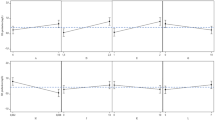Abstract
This study aimed at optimizing the production of hyaluronic acid by Lactobacillus acidophilus FTDC 1231 using response surface methodology and evaluating the effects of divalent metal ions along the production pathway using molecular docking. Among different divalent metal ions that were screened, only iron (II) sulphate and copper (II) sulphate significantly (P < 0.05) affected the production of hyaluronic acid. Subsequent optimization yielded hyaluronic acid at concentration of 0.6152 mg/mL in the presence of 1.24 mol L−1 iron (II) sulphate and 0.16 mol L−1 of copper (II) sulphate (103 % increase compared to absence of divalent metal ions). Data from molecular docking showed Fe2+ improved the binding affinity of UDP-pyrophophorylase towards glucose-1-phosphate, while Cu2+ contributed towards the interaction between UDP-glucose dehydrogenase and UDP-glucose. We have demonstrated that lactobacilli could produce hyaluronic acid at increased concentration upon facilitation by specific divalent metal ions, via specific targets of enzymes and substrates along pentose phosphate pathway.






Similar content being viewed by others
References
Chong, B. F., Blank, L. M., McLaughlin, R., & Nielsen, L. K. (2005). Applied Microbiology and Biotechnology, 66, 341–351.
Don, M. M., & Shoparwe, N. F. (2010). Biochemical Engineering Journal, 49, 95–103.
Vazquez, J. A., Montemayor, M. I., Fraguas, J., & Murado, M. A. (2010). Microbial Cell Factories, 9, 46.
Pires, A. M., Macedo, A. C., Eguchi, S. Y., & Santana, M. H. (2010). Bioresource Technology, 101, 6506–6509.
Widner, B., Behr, R., Von Dollen, S., Tang, M., Heu, T., Sloma, A., Sternberg, D., Deangelis, P. L., Weigel, P. H., & Brown, S. (2005). Applied and Environmental Microbiology, 71, 3747–3752.
Izawa, N., Hanamizu, T., Iizuka, R., Sone, T., Mizukoshi, H., Kimura, K., & Chiba, K. (2009). Journal of Bioscience and Bioengineering, 107, 119–123.
Liu, L., Du, G., Chen, J., Zhu, Y., Wang, M., & Sun, J. (2009). Bioresource Technology, 100, 362–367.
Kim, J. H., Yoo, S. J., Oh, D. K., Kweon, Y. G., Park, D. W., Lee, C. H., & Gil, G. H. (1996). Enzyme and Microbial Technology, 19, 440–445.
Pinto, D., Marzani, B., Minervini, F., Calasso, M., Giuliani, G., Gobbetti, M., & De Angelis, M. (2011). Peptides, 32, 1815–1824.
Fitzpatrick, J. J., Ahrens, M., & Smith, S. (2001). Process Biochemistry, 36, 671–675.
Lew, L. C., Gan, C. Y., & Liong, M. T. (2012). Journal of Applied Microbiology, 114, 526–535.
Elli, M., Zink, R., Rytz, A., Reniero, R., & Morelli, L. (2000). Journal of Applied Microbiology, 88, 695–703.
Lew, L. C., Gan, C. Y., & Liong, M. T. (2013). Annals of Microbiology, 63, 1047–1055.
Yeo, S. K., & Liong, M. T. (2010). Journal of the Science of Food and Agriculture, 90, 267–275.
Morris, G. M., Huey, R., Lindstrom, W., Sanner, M. F., Belew, R. K., Goodsell, D. S., & Olson, A. J. (2009). Journal Computational Chemisrty, 30, 2785–2791.
Humphrey, W., Dalke, A., & Schulten, K. (1996). Journal of Molecular Graphics, 14, 33–38. 27-38.
Wallace, A. C., Laskowski, R. A., & Thornton, J. M. (1995). Protein Engineering, 8, 127–134.
Liong, M. T., Dunshea, F. R., & Shah, N. P. (2007). The British Journal of Nutrition, 98, 736–744.
Liong, M. T., & Shah, N. P. (2005). Journal of Applied Microbiology, 99, 783–793.
Lew, L. C., & Liong, M. T. (2013). Journal of Applied Microbiology, 114, 1241–1253.
Price, R. D., Berry, M. G., & Navsaria, H. A. (2007). Journal of Plastic, Reconstructive & Aesthetic Surgery, 60, 1110–1119.
Fung, W. Y., Woo, Y. P., & Liong, M. T. (2008). Journal of Agricultural and Food Chemistry, 56, 7910–7918.
Teh, S. S., Ahmad, R., Wan-Abdullah, W. N., & Liong, M. T. (2009). Journal of Agricultural and Food Chemistry, 57, 10187–10198.
Liu, L., Wang, M., Du, G., & Chen, J. (2008). Letters in Applied Microbiology, 46, 383–388.
Acknowledgements
This work was financially supported by the Science Fund Grant (305/PTEKIND/613222) provided by the Malaysian Ministry of Science, Technology and Innovation (MOSTI), the FRGS grant (203/PTEKIND/6711239) provided by the Malaysian Ministry of Higher Education (MOHE), USM RU grants (1001/PKIMIA/855006, 1001/PTEKIND/815085) and USM Fellowship provided by Universiti Sains Malaysia.
Author information
Authors and Affiliations
Corresponding author
Rights and permissions
About this article
Cite this article
Choi, SB., Lew, LC., Hor, KC. et al. Fe2+ and Cu2+ Increase the Production of Hyaluronic Acid by Lactobacilli via Affecting Different Stages of the Pentose Phosphate Pathway. Appl Biochem Biotechnol 173, 129–142 (2014). https://doi.org/10.1007/s12010-014-0822-5
Received:
Accepted:
Published:
Issue Date:
DOI: https://doi.org/10.1007/s12010-014-0822-5




